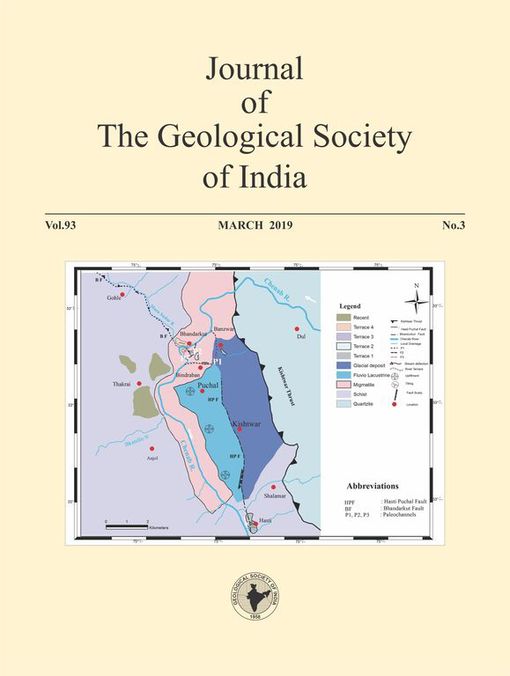Itacolumite (Flexible Sandstone) From Kaliana, Charkhi Dadri District, Haryana, India
DOI:
https://doi.org/10.1007/s12594-019-1174-0Keywords:
No keywordsAbstract
The objective of this study is to highlight main causes of flexibility in itacolumite from Kaliana Hills, Charkhi Dadri district, Haryana. Results of petrominerological studies, scanning electron microscopy (SEM), 3D analysis of SEM images, and quantitative micro fabric analysis reveal that the intergranular void spaces are significantly higher in more flexible specimen (mean 47.68 μm) relative to less flexible specimen (mean 14.32 μm, i.e., <3 times), whereas, non-flexible sandstones show negligible intergranular void spaces (4.97-6.40 μm). Therefore, it may be envisaged that the flexibility in Kaliana itacolumite is due to the presence of more intergranular void spaces. The chemical corrosion appears to be the main reason for the formation of more void spaces in between the constituent grains in the flexible sandstones. Leaching effect on the grains is evident on scanning electron microscopic (SEM) images. These solution channels and embayment might have removed the significant amount of cementing material and silica by dissolution and solution activity. Thus, obviously, the flexibility in the itacolumite was induced by solution activity, more the solution activity, more the void spaces and hence more resultant flexibility. Almost vertically dipping beds of sandstone would have facilitated capillary movement and solutioning leading to development of concomitant leaching induced porosity. Higher degree of flexibility in itacolumite specimen from quarry dump, compared to in-situ fresh itacolumite specimen, is apparently due to more exposure of former to surface processes like weathering, more solution activity and corrosion leading to more removal of cementing material and silica accompanied by concomitant augmentation of considerable intergranular void spaces (>3 times), relative to the latter. It is thus clear that relatively less flexibility in in-situ itacolumite is linked with its less solutioning relative to itacolumite from dump. Thermal shock resistance property of itacolumite can be used as a model material to process synthetic flexible ceramics by mixing phases with large differences of thermal expansion properties.Downloads
Metrics
Issue
Section
Downloads
Published
How to Cite
References
Balfour, E. (1885) The Cyclopaedia of India and of Eastern and Southern Asia, 3rd ed., Morrison & Gibb, Edinburgh.
Bannister, Cowan and Company (1869) Resources of North Carolina: It's natural wealth, condition, and advantages, as existing in 1869, Presented to the Capitalists and People of the Central and NorthernStates. Bannister & Cowan, Wilmington, North Carolina.
Blake, W.B. (1876) On itacolumite. Proc. Acad. Nat. Sci. Philadelphia, v.28, pp.325-326.
Card, G. (1892) On the flexibility of rocks with special mention to the flexible limestone of Durham. Geol. Magz., v.9, pp.117–124.
Derby, O. A. (1882) Modes of occurrence of the diamond in Brazil. Amer.Jour. Sci., v.25, pp.34-42.
Derby, O.A. (1884) On the flexibility of itacolumite. Amer. Jour. Sci., v.28, pp.205-08.
Derby, O. A. (1898) On the accessory elements of itacolumite, and the secondary enlargement of tourmaline. Amer. Jour. Sci., v.5, pp.187-192.
Doncieux, A., Stagnol, D., Huger, M., Chotard, T., Gault, C., Ota, T., and Hashimoto, S. (2008) Thermo-elastic behaviour of a natural quartzite: Itacolumite. Jour. Materials Sci., v.43(12), pp. 4167–4174.
Dusseault, M. B. (1980) Itacolumite: The flexible sandstones. Quart. Jour.Engg. Geol., v.13, pp.119-128.
Fedden, F. (1877) Flexible sandstone. In: Hughes (Ed.) Wardha Valley Coal Field. Mem. Geol. Surv. India, v.XIII Pt. 1, pp.16.
Ginsburg, L. and Lucas, G. (1949) Presence de quartzites elastiques dans les gres armoricains de Berrien (Finistere). Comptes Rendue, pp.1657–1658.
Grant, W.H. (1950). Petrography of three Georgia itacolumites. Georgia Department of Mines Mining and Geology, v.56, pp.91–96.
Hacket, C.A. (1868). On the geology of the Arvali Region, Central and Eastern.Rec. Geol. Surv. India, v.XIV, pp.279–303.
Hawkins, A.C. (1951) Flexible sandstone. The Mineralogist, v.19, pp.34.
Heusser, C. and Claraz, G. (1861) Description of the rocks in which diamonds are found and the manner of working them in the province of Minas Gerais, in Brazil. The Geologist, pp.163–8.
Howard, J. L. (2005) The quartzite problem revisited. Jour. Geol., v.113, pp.707713.
Kerbey, H.C. (2011) Itacolumite, flexible sandstone and flexible quartzite - a review. Proc. Geol. Assoc., v.122, pp.16–24.
Medlicott, H.B. (1874) A note on the habitat in India of the elastic sandstone, or so called itacolumyte. Rec. Geol. Surv. India, v.7, pp.30-31.
Morgan, A. (1876) A note on itacolumite, or flexible sandstone. Proc. Liverpool Geol. Soc., no.iii, pp.148–151.
Oldham, R.D. (1889). On flexible sandstone or itacolumite, with special reference to its nature and mode of occurrence in India, and the cause of its flexibility. Rec. Geol. Surv. India, v.XXII, pp.51–56.
Pande, I.C. and Gupta, V.J. (1969) Flexible sandstone in the rocks of the Delhi System. Research Bulletin (N.S.), Panjab University, v.20, pp.589– 90.
Pittman, E. F. (1892) Flexible sandstone. Geol. Mag., v.9, pp.335.
Siegesmund, S., Volbrecht, A. and Hulka, C. (2002) The anisotropy of itacolumite flexibility. Jour. Geol. Soc. London, v.205, pp.137-147.
Sato, I., Ichikawa, Y., Sakanoue, J., Mizutani, M., Adachi, N., and Ota, T.(2008). Flexible ceramics in the system KZr2(PO4)3 - KAlSi2O6 prepared by mimicking the microstructure of itacolumite. Jour. Amer. Ceramic Soc., v.91(2), pp.607–610.
Suzuki, H. and Shimizu, D. (1993) Petrography of Indian, Brazilian and Appalachian itacolumite. Jour. Geol. Soc. Japan, v.99, pp.391–401.
Suzuki, H., Yokoyama, T. and Nishihara, M. (1993) Scanning electron microscope and acoustic emission studies of itacolumite. Jour. Geol. Soc.Japan, v.99, pp.443-456.
Verma, V.K. (1982) Flexibility in itacolumites from Brazil, India and United States. Jour. Indian Assoc. Sediment., v.3, pp.19-28.

 Pawan Kumar
Pawan Kumar






